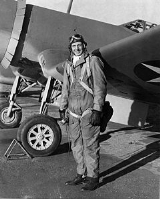
Boone Guyton
Encyclopedia
Boone Tarleton Guyton United States Navy
, (September 4, 1913 – April 4, 1996) was a Naval Aviation Cadet, experimental test pilot
, author and businessman. In a flying career spanning the biplane era through the jet age, Guyton was perhaps best known for his test pilot years at Vought-Sikorsky (Chance Vought) and his participation in the development of the F4U Corsair
and various other military aircraft including the OS2U Kingfisher
and the radical Vought V-173
flying pancake.
, September 4, 1913. His birth certificate incorrectly spelled his first name “Bond” but was later corrected. His father William Henry Guyton, the Superintendent Transportation, E. St. Louis & Suburban Railroad, died in 1921 before Boone’s 8th birthday. His mother, Martha (Windhorst) Guyton raised Boone and his older brother William, much of it during the depression. Boone graduated from East St. Louis High School in 1931.
Guyton then attended Central Methodist College in Fayette, Missouri, graduating in 1935 and starring on the 1934 football team which won the Missouri College Athletic Union (MCAU) championship. Guyton played end and led the league in scoring, setting a college record for most touchdowns caught in the end-zone (seven). He was named on the all-conference team and earned a mention in Ripley’s Believe It or Not for having scored all his touchdowns without carrying the ball across the goal line.

 In 1927 at the age of 14, Guyton became fascinated by aviation as he monitored the feats of Charles Lindbergh
In 1927 at the age of 14, Guyton became fascinated by aviation as he monitored the feats of Charles Lindbergh
in the Spirit of St. Louis
. Lindbergh was young Guyton’s consummate hero, though Guyton would later feel that a flying career would be economically impossible to pursue.
Upon graduating from College in 1935, with the Great Depression in the United States
, Guyton’s options were few and far between. His college dean, feeling he would be a good teacher helped Guyton land a teaching position. Though grateful, Guyton felt uneasy and did not perceive himself a teacher.
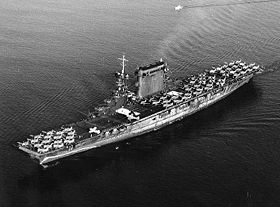 Just after the teaching offer, a large brown envelope arrived from the U.S. Navy announcing a new aviation cadet program at Naval Air Station Pensacola
Just after the teaching offer, a large brown envelope arrived from the U.S. Navy announcing a new aviation cadet program at Naval Air Station Pensacola
, Florida. Guyton pursued the offer and was accepted. In 1936 he graduated tenth in the first graduating class despite a 44% attrition rate.
For the next three years, Guyton flew for the Navy out of Naval Air Station North Island
San Diego, California and off carriers USS Lexington (CV-2)
and USS Saratoga (CV-3)
in various locations around the world, including Midway, Honolulu, the French Frigate Shoals, the Aleutians and Panama. Guyton was a member of Bombing Squadron Five flying mostly Boeing F4B-4s. In 1937, it was Guyton’s squadron on the USS Lexington which took part in the search for Amelia Earhart. Guyton, however, was on leave at the time.
factory in a “study in frenzy”, preparing for France and learning as much as possible about the SB2U Vindicator
(the French version of that plane had been dubbed the V-156) before departing for Paris.
Also during those three days, Guyton caught a glimpse of a mockup of Vought's next generation high-speed, single-seat fighter, the XF4U-1. The production version would later be known as the F4U Corsair
. He departed for Paris on the French liner SS Champlain
, arriving in Paris in August, 1939, less than a month before the Nazi Blitzkrieg
against Poland and the beginning of WWII.
. He was later moved to Brest, (flying out of the air station at Lanvéoc Poulmic) after the nighttime curfews, air-raid sirens and trips to the bomb shelters became all-too-frequent occurrences in Paris. The bulk of Guyton’s time was spent testing the new V-156 aircraft as they arrived from the U.S. and training various French pilots. The planes were to be used, it was believed, to attack Nazi tanks when they arrived.
While stationed at Orly Field, Guyton nearly became only the second American pilot to fly the vaunted Messerschmitt Bf 109
fighter prior to WWII (the only known American to fly it at that time was Charles Lindbergh himself, who had flown it in 1938 and praised its abilities). The Messerschmitt pilot had landed in France with engine trouble earlier that year and the plane was brought to the French Aerodrome at Bricy, near Orly. Guyton had arranged a test flight following French racing pilot Michel Detroyat, winner of the Thompson Trophy
just three years earlier in Los Angeles. Unfortunately, Detroyat experienced mechanical troubles with the Messerschmitt’s brakes and plane was damaged upon landing to the extent that Guyton would miss his opportunity.
By the time January 1940 arrived with rising tensions in Europe, Nazis threatening France and the pressures of so-called neutrality laws, Vought terminated Guyton’s assignment and sent him back to the States. He exited France via Italy where he boarded the ocean liner which ran under the American flag and was theoretically safe from German U-boat attacks as it headed through the Strait of Gibraltar. Guyton arrived in New York harbor on January 24, 1940.
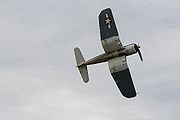 Upon returning to the States, Guyton found himself once again looking for work. Things at Vought were quiet as the new XF4U-1 Corsair prototype was not yet airworthy and the OS2U Kingfisher
Upon returning to the States, Guyton found himself once again looking for work. Things at Vought were quiet as the new XF4U-1 Corsair prototype was not yet airworthy and the OS2U Kingfisher
had yet to roll off the assembly line. With no other options, Guyton accepted an offer from TWA and finally flew for the airline he’d passed up three years earlier. Guyton’s airline career officially began on March 6, flying mostly DC-3s.
But as luck would have it, a job offer would arrive from Vought’s Rex Beisel
a mere three months later to fill an open position for an experimental test pilot. At the end of May 1940, Guyton left TWA and reported to Vought’s chief of flight test, Lyman Bullard, shortly before the Corsair’s maiden flight on May 29.
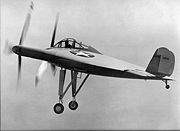 On July 9, Guyton would fly XF4U-1 for the first time. During his fifth flight in the plane, on July 11, Guyton was caught in bad weather during high-speed testing and was forced to make an emergency landing on a golf course as fuel ran out. The Corsair skidded into a group of trees and flipped over, but the damage was luckily repairable and only set the program back two months. Subsequently, Bullard was able to demonstrate the XF4U-1 for the Navy on October 1 while also becoming the first single seat production fighter to surpass 400 mph (Bullard actually reached 405 mph).
On July 9, Guyton would fly XF4U-1 for the first time. During his fifth flight in the plane, on July 11, Guyton was caught in bad weather during high-speed testing and was forced to make an emergency landing on a golf course as fuel ran out. The Corsair skidded into a group of trees and flipped over, but the damage was luckily repairable and only set the program back two months. Subsequently, Bullard was able to demonstrate the XF4U-1 for the Navy on October 1 while also becoming the first single seat production fighter to surpass 400 mph (Bullard actually reached 405 mph).
Guyton continued testing the XF4U-1 Corsair as well as various versions of the SB2U Vindicator
and OS2U Kingfisher
. On 25 June 1942, he would fly the first production F4U-1 Corsair to roll of the assembly line and from that point on, the pace of the Corsair testing became frenetic and Guyton would spend much less time in the other aircraft. Back in the F4U-1 on June 26, Guyton then got married on the 27th, took one day off and returned to flight testing on the 29th. The next few years also included frequent trips to Navy bases around the country to train Navy pilots on the fighter that would soon carry them into combat. One such "student" was Captain Tom Blackburn of the VF-17; also known as the VFA-103
"Jolly Rogers".
Outside of his Corsair testing efforts, Guyton was also named the chief experimental test pilot for the Vought V-173
“flying flapjack” (or flying pancake) prototype. He took the V-173 on its maiden flight on November 23, 1942. Destined to become the next great propeller driven fighter design, development of the XF5U (the high speed fighter version of the V-173) would be stopped in 1947 before it ever flew. The Navy had switched focus to jet-propelled aircraft.
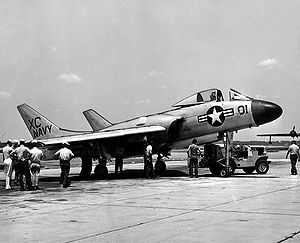 In late October 1944, Guyton participated in Navy Fighter Meet at NAS Patuxent River, Maryland where pilots from the military and various manufacturers tested and compared military aircraft. It was there that he finally got a chance to fly a captured Japanese A6M Zero
In late October 1944, Guyton participated in Navy Fighter Meet at NAS Patuxent River, Maryland where pilots from the military and various manufacturers tested and compared military aircraft. It was there that he finally got a chance to fly a captured Japanese A6M Zero
fighter and the revolutionary, jet propelled Bell YP–59A Airacomet.
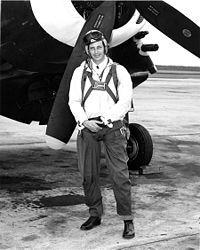 By 1945, Guyton had logged more than 650 hours testing Corsairs (XF4U-1, F4U-1, XF4U-3, XF4U-4, F4U-4 etc.) and nearly 33 hours in the V-173
By 1945, Guyton had logged more than 650 hours testing Corsairs (XF4U-1, F4U-1, XF4U-3, XF4U-4, F4U-4 etc.) and nearly 33 hours in the V-173
In 1948 Vought moved the factory from Stratford, Connecticut to Dallas, Texas. Guyton continued to fly later iterations of the Corsair (F4U-7 and AU-1) as well as Vought jets: the F6U Pirate
and the F7U Cutlass
. He decided to leave Vought in 1951 after 12 years, completing his career as an experimental test pilot. His last flight for Vought occurred on April 17, 1951 when he volunteered to deliver a F6U Pirate
from Texas to Sorocco, New Mexico where it would join other discarded, obsolete aircraft. During the flight, a hydraulic failure forced Guyton to make an emergency landing, which he managed to walk away from unscathed.
began consulting to Vought, related primarily to the engineering of the F4U. Both Lyman Bullard and Guyton debriefed the legendary pilot on the characteristics of the F4U-1 before Lindbergh’s first Corsair flight on January 6, 1943. Lindbergh flew the plane three more times on January 6 and then left Vought, not returning for a month.
At dinner one night, Lindbergh and Guyton shared some thoughts. Some were on aeronautical subjects and some not, including their mutual acquaintance, French pilot Michel Detroyat. Lindbergh mentioned that it was Detroyat who rescued him from the masses of exuberant fans the night he landed the ‘’Spirit of St. Louis’’ at Le Bourget.
In March 1943, Guyton suffered a near-fatal crash landing after the engine in his F4U seized at 22,000 feet and he attempted to glide it back to the factory’s airport where it literally broke in half upon impact. One of his first visitors at Bridgeport hospital, besides Guyton’s wife, was Lindbergh himself.
Guyton’s relationship with Lindbergh continued throughout the war including a dinner at the newly acquired Lindbergh Westport, Connecticut
home in late 1944
where they conceived a fifth child. Career-wise, Guyton assumed various management positions at Hamilton Standard
, United Technologies Corporation
- Missiles and Space Division, and eventually his own company. Guyton continued to fly recreationally until 1982 when he stopped for good, forty-seven years after joining the Naval Aviation Cadet program. He flew over 100 different aircraft including almost all of the top fighters of WWII (P-51 Mustang
, Supermarine Spitfire
, P-47 Thunderbolt
, P-38 Lightning
, F4F Wildcat
, Japanese Zero, F6F Hellcat
, Curtiss P-40
), but he is best remembered as the chief experimental test pilot for the Corsair.
During his retirement years, Guyton lectured on the Corsair and V-173 and continued to write. His third and last book, Whistling Death – the Test Pilot’s Story of the F4U Corsair, was published in 1990.
United States Navy
The United States Navy is the naval warfare service branch of the United States Armed Forces and one of the seven uniformed services of the United States. The U.S. Navy is the largest in the world; its battle fleet tonnage is greater than that of the next 13 largest navies combined. The U.S...
, (September 4, 1913 – April 4, 1996) was a Naval Aviation Cadet, experimental test pilot
Test pilot
A test pilot is an aviator who flies new and modified aircraft in specific maneuvers, known as flight test techniques or FTTs, allowing the results to be measured and the design to be evaluated....
, author and businessman. In a flying career spanning the biplane era through the jet age, Guyton was perhaps best known for his test pilot years at Vought-Sikorsky (Chance Vought) and his participation in the development of the F4U Corsair
F4U Corsair
The Vought F4U Corsair was a carrier-capable fighter aircraft that saw service primarily in World War II and the Korean War. Demand for the aircraft soon overwhelmed Vought's manufacturing capability, resulting in production by Goodyear and Brewster: Goodyear-built Corsairs were designated FG and...
and various other military aircraft including the OS2U Kingfisher
OS2U Kingfisher
The Vought OS2U Kingfisher was an American catapult-launched observation floatplane. It was a compact mid-wing monoplane, with a large central float and small stabilizing floats. Performance was modest, because of its light engine...
and the radical Vought V-173
Vought V-173
|-See also:-References:NotesBibliography* Chant, Christopher. Fantastic Aircraft. New York: Gallery Books, 1984. ISBN 0-8317-3-189-3.* Ginter, Steve. Chance Vought V-173 and XFU-1 Flying Pancakes . Simi Valley, CA: Steve Ginter Publishing, 1992. ISBN 0-942612-21-3.* Guyton, Boone T...
flying pancake.
Early life
Guyton was born in East St. Louis, IllinoisEast St. Louis, Illinois
East St. Louis is a city located in St. Clair County, Illinois, USA, directly across the Mississippi River from St. Louis, Missouri in the Metro-East region of Southern Illinois. As of the 2010 census, the city had a total population of 27,006, less than one-third of its peak of 82,366 in 1950...
, September 4, 1913. His birth certificate incorrectly spelled his first name “Bond” but was later corrected. His father William Henry Guyton, the Superintendent Transportation, E. St. Louis & Suburban Railroad, died in 1921 before Boone’s 8th birthday. His mother, Martha (Windhorst) Guyton raised Boone and his older brother William, much of it during the depression. Boone graduated from East St. Louis High School in 1931.
Guyton then attended Central Methodist College in Fayette, Missouri, graduating in 1935 and starring on the 1934 football team which won the Missouri College Athletic Union (MCAU) championship. Guyton played end and led the league in scoring, setting a college record for most touchdowns caught in the end-zone (seven). He was named on the all-conference team and earned a mention in Ripley’s Believe It or Not for having scored all his touchdowns without carrying the ball across the goal line.
Introduction to Aviation


Charles Lindbergh
Charles Augustus Lindbergh was an American aviator, author, inventor, explorer, and social activist.Lindbergh, a 25-year-old U.S...
in the Spirit of St. Louis
Spirit of St. Louis
The Spirit of St. Louis is the custom-built, single engine, single-seat monoplane that was flown solo by Charles Lindbergh on May 20–21, 1927, on the first non-stop flight from New York to Paris for which Lindbergh won the $25,000 Orteig Prize.Lindbergh took off in the Spirit from Roosevelt...
. Lindbergh was young Guyton’s consummate hero, though Guyton would later feel that a flying career would be economically impossible to pursue.
Upon graduating from College in 1935, with the Great Depression in the United States
Great Depression in the United States
The Great Depression began with the Wall Street Crash of October, 1929 and rapidly spread worldwide. The market crash marked the beginning of a decade of high unemployment, poverty, low profits, deflation, plunging farm incomes, and lost opportunities for economic growth and personal advancement...
, Guyton’s options were few and far between. His college dean, feeling he would be a good teacher helped Guyton land a teaching position. Though grateful, Guyton felt uneasy and did not perceive himself a teacher.

Naval Air Station Pensacola
Naval Air Station Pensacola or NAS Pensacola , "The Cradle of Naval Aviation", is a United States Navy base located next to Warrington, Florida, a community southwest of the Pensacola city limits...
, Florida. Guyton pursued the offer and was accepted. In 1936 he graduated tenth in the first graduating class despite a 44% attrition rate.
For the next three years, Guyton flew for the Navy out of Naval Air Station North Island
Naval Air Station North Island
Naval Air Station North Island or NAS North Island is located at the north end of the Coronado peninsula on San Diego Bay and is the home port of several aircraft carriers of the United States Navy...
San Diego, California and off carriers USS Lexington (CV-2)
USS Lexington (CV-2)
USS Lexington , nicknamed the "Gray Lady" or "Lady Lex," was an early aircraft carrier of the United States Navy. She was the lead ship of the , though her sister ship was commissioned a month earlier...
and USS Saratoga (CV-3)
USS Saratoga (CV-3)
USS Saratoga was the second aircraft carrier of the United States Navy and the fifth ship to bear her name. She was commissioned one month earlier than her sister and class leader, , which is the third actually commissioned after and Saratoga...
in various locations around the world, including Midway, Honolulu, the French Frigate Shoals, the Aleutians and Panama. Guyton was a member of Bombing Squadron Five flying mostly Boeing F4B-4s. In 1937, it was Guyton’s squadron on the USS Lexington which took part in the search for Amelia Earhart. Guyton, however, was on leave at the time.
Test Pilot
Nearing the end of his three years as a Naval aviator, Guyton attended a TWA ground school for the DC-3 aircraft. With only a few weeks remaining at NAS North Island, Guyton reluctantly accepted a position to join TWA as a co-pilot. However, with just days remaining in the Navy, Guyton met a factory representative from Vought-Sikorsky and subsequently landed a test-pilot position for Vought teaching the French Navy to fly American dive-bombers. His last day as a Navy pilot was July 16, 1939. Guyton spent the next three days at Vought’s Stratford, ConnecticutStratford, Connecticut
Stratford is a town in Fairfield County, Connecticut, United States, located on Long Island Sound at the mouth of the Housatonic River. It was founded by Puritans in 1639....
factory in a “study in frenzy”, preparing for France and learning as much as possible about the SB2U Vindicator
SB2U Vindicator
The Vought SB2U Vindicator was a carrier-based dive bomber developed for the United States Navy in the 1930s, the first monoplane in this role. Obsolescent at the outbreak of World War II, Vindicators still remained in service at the time of the Battle of Midway, but by 1943, all had been withdrawn...
(the French version of that plane had been dubbed the V-156) before departing for Paris.
Also during those three days, Guyton caught a glimpse of a mockup of Vought's next generation high-speed, single-seat fighter, the XF4U-1. The production version would later be known as the F4U Corsair
F4U Corsair
The Vought F4U Corsair was a carrier-capable fighter aircraft that saw service primarily in World War II and the Korean War. Demand for the aircraft soon overwhelmed Vought's manufacturing capability, resulting in production by Goodyear and Brewster: Goodyear-built Corsairs were designated FG and...
. He departed for Paris on the French liner SS Champlain
SS Champlain
The SS Champlain was a cabin class ocean liner built in 1932 for the French Line by Chantiers et Ateliers de Saint-Nazaire, Penhoët. She was sunk by a mine off La Pallice, France, in 1940 -- one of the earliest passenger ship losses of the Second World War.Although not as well remembered as her...
, arriving in Paris in August, 1939, less than a month before the Nazi Blitzkrieg
Blitzkrieg
For other uses of the word, see: Blitzkrieg Blitzkrieg is an anglicized word describing all-motorised force concentration of tanks, infantry, artillery, combat engineers and air power, concentrating overwhelming force at high speed to break through enemy lines, and, once the lines are broken,...
against Poland and the beginning of WWII.
In France, With War Looming
Guyton spent six months in France, first living in Paris and flying out of Orly AirportOrly Airport
Paris-Orly Airport is an airport located partially in Orly and partially in Villeneuve-le-Roi, south of Paris, France. It has flights to cities in Europe, the Middle East, Africa, the Caribbean, North America and Southeast Asia. Prior to the construction of Charles de Gaulle Airport, Orly was...
. He was later moved to Brest, (flying out of the air station at Lanvéoc Poulmic) after the nighttime curfews, air-raid sirens and trips to the bomb shelters became all-too-frequent occurrences in Paris. The bulk of Guyton’s time was spent testing the new V-156 aircraft as they arrived from the U.S. and training various French pilots. The planes were to be used, it was believed, to attack Nazi tanks when they arrived.
While stationed at Orly Field, Guyton nearly became only the second American pilot to fly the vaunted Messerschmitt Bf 109
Messerschmitt Bf 109
The Messerschmitt Bf 109, often called Me 109, was a German World War II fighter aircraft designed by Willy Messerschmitt and Robert Lusser during the early to mid 1930s...
fighter prior to WWII (the only known American to fly it at that time was Charles Lindbergh himself, who had flown it in 1938 and praised its abilities). The Messerschmitt pilot had landed in France with engine trouble earlier that year and the plane was brought to the French Aerodrome at Bricy, near Orly. Guyton had arranged a test flight following French racing pilot Michel Detroyat, winner of the Thompson Trophy
Thompson trophy
The Thompson Trophy race was one of the National Air Races of the heyday of early airplane racing in the 1930s. Established in 1929, the last race was held in 1961. The race was long with pylons marking the turns, and emphasized low altitude flying and maneuverability at high speeds...
just three years earlier in Los Angeles. Unfortunately, Detroyat experienced mechanical troubles with the Messerschmitt’s brakes and plane was damaged upon landing to the extent that Guyton would miss his opportunity.
By the time January 1940 arrived with rising tensions in Europe, Nazis threatening France and the pressures of so-called neutrality laws, Vought terminated Guyton’s assignment and sent him back to the States. He exited France via Italy where he boarded the ocean liner which ran under the American flag and was theoretically safe from German U-boat attacks as it headed through the Strait of Gibraltar. Guyton arrived in New York harbor on January 24, 1940.
The Vought Years

OS2U Kingfisher
The Vought OS2U Kingfisher was an American catapult-launched observation floatplane. It was a compact mid-wing monoplane, with a large central float and small stabilizing floats. Performance was modest, because of its light engine...
had yet to roll off the assembly line. With no other options, Guyton accepted an offer from TWA and finally flew for the airline he’d passed up three years earlier. Guyton’s airline career officially began on March 6, flying mostly DC-3s.
But as luck would have it, a job offer would arrive from Vought’s Rex Beisel
Rex Beisel
Rex Buren Beisel was an aeronautical engineer who led the design of the Vought F7U Cutlass, Vought F4U Corsair and won the Wright Brothers Medal in 1934 for work related to the cooling of radial aircraft engines. Beisel grew up in Cumberland, Washington and graduated from the University of...
a mere three months later to fill an open position for an experimental test pilot. At the end of May 1940, Guyton left TWA and reported to Vought’s chief of flight test, Lyman Bullard, shortly before the Corsair’s maiden flight on May 29.

Guyton continued testing the XF4U-1 Corsair as well as various versions of the SB2U Vindicator
SB2U Vindicator
The Vought SB2U Vindicator was a carrier-based dive bomber developed for the United States Navy in the 1930s, the first monoplane in this role. Obsolescent at the outbreak of World War II, Vindicators still remained in service at the time of the Battle of Midway, but by 1943, all had been withdrawn...
and OS2U Kingfisher
OS2U Kingfisher
The Vought OS2U Kingfisher was an American catapult-launched observation floatplane. It was a compact mid-wing monoplane, with a large central float and small stabilizing floats. Performance was modest, because of its light engine...
. On 25 June 1942, he would fly the first production F4U-1 Corsair to roll of the assembly line and from that point on, the pace of the Corsair testing became frenetic and Guyton would spend much less time in the other aircraft. Back in the F4U-1 on June 26, Guyton then got married on the 27th, took one day off and returned to flight testing on the 29th. The next few years also included frequent trips to Navy bases around the country to train Navy pilots on the fighter that would soon carry them into combat. One such "student" was Captain Tom Blackburn of the VF-17; also known as the VFA-103
VFA-103
Strike Fighter Squadron 103 , nicknamed the Jolly Rogers is an aviation unit of the United States Navy established in 1952. VFA-103 flies the F/A-18F Super Hornet and is based at Naval Air Station Oceana, Virginia...
"Jolly Rogers".
Outside of his Corsair testing efforts, Guyton was also named the chief experimental test pilot for the Vought V-173
Vought V-173
|-See also:-References:NotesBibliography* Chant, Christopher. Fantastic Aircraft. New York: Gallery Books, 1984. ISBN 0-8317-3-189-3.* Ginter, Steve. Chance Vought V-173 and XFU-1 Flying Pancakes . Simi Valley, CA: Steve Ginter Publishing, 1992. ISBN 0-942612-21-3.* Guyton, Boone T...
“flying flapjack” (or flying pancake) prototype. He took the V-173 on its maiden flight on November 23, 1942. Destined to become the next great propeller driven fighter design, development of the XF5U (the high speed fighter version of the V-173) would be stopped in 1947 before it ever flew. The Navy had switched focus to jet-propelled aircraft.

A6M Zero
The Mitsubishi A6M Zero was a long-range fighter aircraft operated by the Imperial Japanese Navy Air Service from 1940 to 1945. The A6M was designated as the , and also designated as the Mitsubishi A6M Rei-sen and Mitsubishi Navy 12-shi Carrier Fighter. The A6M was usually referred to by the...
fighter and the revolutionary, jet propelled Bell YP–59A Airacomet.

In 1948 Vought moved the factory from Stratford, Connecticut to Dallas, Texas. Guyton continued to fly later iterations of the Corsair (F4U-7 and AU-1) as well as Vought jets: the F6U Pirate
F6U Pirate
|-See also:-References:NotesBibliography* Green, William and Gordon Swanborough. The Complete Book of Fighters. New York: Barnes & Noble Inc., 1988, ISBN 0-07607-0904-1....
and the F7U Cutlass
F7U Cutlass
The Vought F7U Cutlass was a United States Navy carrier-based jet fighter and fighter-bomber of the early Cold War era. It was a highly unusual, semi-tailless design, allegedly based on aerodynamic data and plans captured from the German Arado company at the end of World War II, though Vought...
. He decided to leave Vought in 1951 after 12 years, completing his career as an experimental test pilot. His last flight for Vought occurred on April 17, 1951 when he volunteered to deliver a F6U Pirate
F6U Pirate
|-See also:-References:NotesBibliography* Green, William and Gordon Swanborough. The Complete Book of Fighters. New York: Barnes & Noble Inc., 1988, ISBN 0-07607-0904-1....
from Texas to Sorocco, New Mexico where it would join other discarded, obsolete aircraft. During the flight, a hydraulic failure forced Guyton to make an emergency landing, which he managed to walk away from unscathed.
The Lindbergh Connection
In early 1943, Charles LindberghCharles Lindbergh
Charles Augustus Lindbergh was an American aviator, author, inventor, explorer, and social activist.Lindbergh, a 25-year-old U.S...
began consulting to Vought, related primarily to the engineering of the F4U. Both Lyman Bullard and Guyton debriefed the legendary pilot on the characteristics of the F4U-1 before Lindbergh’s first Corsair flight on January 6, 1943. Lindbergh flew the plane three more times on January 6 and then left Vought, not returning for a month.
At dinner one night, Lindbergh and Guyton shared some thoughts. Some were on aeronautical subjects and some not, including their mutual acquaintance, French pilot Michel Detroyat. Lindbergh mentioned that it was Detroyat who rescued him from the masses of exuberant fans the night he landed the ‘’Spirit of St. Louis’’ at Le Bourget.
In March 1943, Guyton suffered a near-fatal crash landing after the engine in his F4U seized at 22,000 feet and he attempted to glide it back to the factory’s airport where it literally broke in half upon impact. One of his first visitors at Bridgeport hospital, besides Guyton’s wife, was Lindbergh himself.
Guyton’s relationship with Lindbergh continued throughout the war including a dinner at the newly acquired Lindbergh Westport, Connecticut
Westport, Connecticut
-Neighborhoods:* Saugatuck – around the Westport railroad station near the southwestern corner of the town – a built-up area with some restaurants, stores and offices....
home in late 1944
Post Vought Years
Leaving Vought, Guyton returned to New England with his wife and four children, settling in Woodbridge, ConnecticutWoodbridge, Connecticut
Woodbridge is a town in New Haven County, Connecticut, United States. The population was 8,983 at the 2000 census. It is one of the wealthiest towns in Connecticut, ranking 16th in the state in terms of per capita income, and is home to many of the faculty of Yale University...
where they conceived a fifth child. Career-wise, Guyton assumed various management positions at Hamilton Standard
Hamilton Standard
Hamilton Standard, an aircraft propeller parts supplier, was formed in 1929 when United Aircraft and Transport Corporation consolidated Hamilton Aero Manufacturing and Standard Steel Propeller into the Hamilton Standard Propeller Corporation. Other members of the corporation included Boeing,...
, United Technologies Corporation
United Technologies Corporation
United Technologies Corporation is an American multinational conglomerate headquartered in the United Technologies Building in Hartford, Connecticut...
- Missiles and Space Division, and eventually his own company. Guyton continued to fly recreationally until 1982 when he stopped for good, forty-seven years after joining the Naval Aviation Cadet program. He flew over 100 different aircraft including almost all of the top fighters of WWII (P-51 Mustang
P-51 Mustang
The North American Aviation P-51 Mustang was an American long-range, single-seat fighter and fighter-bomber used during World War II, the Korean War and in several other conflicts...
, Supermarine Spitfire
Supermarine Spitfire
The Supermarine Spitfire is a British single-seat fighter aircraft that was used by the Royal Air Force and many other Allied countries throughout the Second World War. The Spitfire continued to be used as a front line fighter and in secondary roles into the 1950s...
, P-47 Thunderbolt
P-47 Thunderbolt
Republic Aviation's P-47 Thunderbolt, also known as the "Jug", was the largest, heaviest, and most expensive fighter aircraft in history to be powered by a single reciprocating engine. It was heavily armed with eight .50-caliber machine guns, four per wing. When fully loaded, the P-47 weighed up to...
, P-38 Lightning
P-38 Lightning
The Lockheed P-38 Lightning was a World War II American fighter aircraft built by Lockheed. Developed to a United States Army Air Corps requirement, the P-38 had distinctive twin booms and a single, central nacelle containing the cockpit and armament...
, F4F Wildcat
F4F Wildcat
The Grumman F4F Wildcat was an American carrier-based fighter aircraft that began service with both the United States Navy and the British Royal Navy in 1940...
, Japanese Zero, F6F Hellcat
F6F Hellcat
The Grumman F6F Hellcat was a carrier-based fighter aircraft developed to replace the earlier F4F Wildcat in United States Navy service. Although the F6F resembled the Wildcat, it was a completely new design powered by a 2,000 hp Pratt & Whitney R-2800. Some tagged it as the "Wildcat's big...
, Curtiss P-40
Curtiss P-40
The Curtiss P-40 Warhawk was an American single-engine, single-seat, all-metal fighter and ground attack aircraft that first flew in 1938. The P-40 design was a modification of the previous Curtiss P-36 Hawk which reduced development time and enabled a rapid entry into production and operational...
), but he is best remembered as the chief experimental test pilot for the Corsair.
During his retirement years, Guyton lectured on the Corsair and V-173 and continued to write. His third and last book, Whistling Death – the Test Pilot’s Story of the F4U Corsair, was published in 1990.

